Islam
From Wikipedia, the free encyclopedia
For other uses, see Islam (disambiguation).
| [hide]Islam |
|---|
 |
Islam (/ˈɪslɑːm/;[note 1] Arabic: الإسلام, al-ʾIslām IPA: [ælʔɪsˈlæːm] ( )[note 2]) is a monotheistic and Abrahamic religion articulated by the Qur'an, an Islamic holy book considered by its adherents to be the verbatim word of God (Allāh), and for the vast majority of adherents, also by the teachings, normative example and way of life (or sunnah); it also is composed of prophetic traditions (or hadith) of Muhammad (c. 570–8 June 632 CE), considered by most of them to be the last prophet of God. An adherent of Islam is called a Muslim (or Moslem).
)[note 2]) is a monotheistic and Abrahamic religion articulated by the Qur'an, an Islamic holy book considered by its adherents to be the verbatim word of God (Allāh), and for the vast majority of adherents, also by the teachings, normative example and way of life (or sunnah); it also is composed of prophetic traditions (or hadith) of Muhammad (c. 570–8 June 632 CE), considered by most of them to be the last prophet of God. An adherent of Islam is called a Muslim (or Moslem).
Muslims believe that God is one and incomparable[1] and that the purpose of existence is to worship God.[2] Muslims also believe that Islam is the complete and universal version of a primordial faith that was revealed many times before through prophets including Adam, Noah, Abraham, Moses, and Jesus.[3] They maintain that the previous messages and revelations have been partially misinterpreted or altered over time,[4] but consider the Arabic Qur'an to be both the unaltered and the final revelation of God.[5] Religious concepts and practices include the five pillars of Islam, which are basic concepts and obligatory acts of worship, and following Islamic law, which touches on virtually every aspect of life and society, providing guidance on multifarious topics from banking and welfare, to family life and the environment.[6][7]
Most Muslims are of two denominations: Sunni (75–90%)[8] or Shia (10–20%).[9] About 13% of Muslims live in Indonesia,[10] the largest Muslim-majority country, 25% in South Asia,[10] 20% in the Middle East,[11] and 15% in Sub-Saharan Africa.[12] Sizable minorities are also found in Europe, China, Russia, and the Americas. Converts and immigrant communities are found in almost every part of the world (see Islam by country). With about 1.6 billion followers or 23% of world population,[13][14] Islam is the second-largest religion and one of the fastest-growing major religions in the world.[15][16][17]
Contents
[hide]Etymology and meaning
Islam is a verbal noun originating from the triliteral root s-l-m which forms a large class of words mostly relating to concepts of wholeness, safeness and peace.[18] In a religious context it means "voluntary submission to God".[19][20] Muslim, the word for an adherent of Islam, is the active participle of the same verb of which Islām is the infinitive. Believers demonstrate submission to God by serving God, following his commands, and rejecting polytheism. The word sometimes has distinct connotations in its various occurrences in the Qur'an. In some verses, there is stress on the quality of Islam as an internal conviction: "Whomsoever God desires to guide, He opens his heart to Islam."[21]
Other verses connect Islām and dīn (usually translated as "religion"): "Today, I have perfected your religion (dīn) for you; I have completed My blessing upon you; I have approved Islam for your religion."[22] Still others describe Islam as an action of returning to God—more than just a verbal affirmation of faith.[23] In the Hadith of Gabriel, islām is presented as one part of a triad that includes imān (faith), and ihsān (excellence), where islām is defined theologically as Tawhid, historically by asserting that Muhammad is messenger of God, and doctrinally by mandating five basic and fundamental pillars of practice.[24][25]
Articles of faith
God
Main articles: God in Islam and Allah
Islam's most fundamental concept is a rigorous monotheism, called tawḥīd (Arabic: توحيد). God is described in chapter 112 of the Qur'an as:[26] "Say: He is God, the One and Only; God, the Eternal, Absolute; He begetteth not, nor is He begotten; And there is none like unto Him."(112:1-4) Muslims and Jews repudiate the Christian doctrine of the Trinity and divinity of Jesus, comparing it to polytheism. In Islam, God is beyond all comprehension and Muslims are not expected to visualize God.[27][28][29][30] God is described and referred to by certain names or attributes, the most common being Al-Rahmān, meaning "The Compassionate" and Al-Rahīm, meaning "The Merciful" (See Names of God in Islam).[31]
Muslims believe that the creation of everything in the universe was brought into being by God's sheer command, "'Be' and so it is,"[32] and that the purpose of existence is to worship God.[33] He is viewed as a personal god who responds whenever a person in need or distress calls him.[34] There are no intermediaries, such as clergy, to contact God who states, "I am nearer to him than (his) jugular vein."[35] The reciprocal nature is mentioned in the hadith qudsi, "I am as My servant thinks (expects) I am."[36]
Allāh is the term with no plural or gender used by Muslims and Arabic-speaking Christians and Jews to reference God, while ʾilāh (Arabic: إله) is the term used for a deity or a god in general.[37] Other non-Arab Muslims might use different names as much as Allah, for instance "Tanrı" in Turkish, "Khodā" in Persian or Ḵẖudāin Urdu.
Angels
Main article: Islamic view of angels
Angels
|
Belief in angels is fundamental to the faith of Islam. The Arabic word for angel (Arabic: ملك malak) means "messenger", like its counterparts in Hebrew (malakh) and Greek (angelos). According to the Qur'an, angels do not possess free will, and therefore worship and obey God in total obedience. Angels' duties include communicating revelations from God, glorifying God, recording every person's actions, and taking a person's soul at the time of death. Muslims believe that angels are made of light. They are described as "messengers with wings—two, or three, or four (pairs): He [God] adds to Creation as He pleases..."[38]
Revelations
See also: History of the Quran
The Islamic holy books are the records which most Muslims believe were dictated by God to various prophets. Muslims believe that parts of the previously revealed scriptures, the Tawrat (Torah) and the Injil (Gospels), had become distorted—either in interpretation, in text, or both.[4] The Qur'an (literally, "Reading" or "Recitation") is viewed by Muslims as the final revelation and literal word of God and is widely regarded as the finest literary work in the Arabic language.[39][40]
Muslims believe that the verses of the Qur'an were revealed to Muhammad by God through the archangel Gabriel (Jibrīl) on many occasions between 610 CE until his death on June 8, 632.[41]While Muhammad was alive, all of these revelations were written down by his companions (sahabah), although the prime method of transmission was orally through memorization.[42]
The Qur'an is divided into 114 suras, or chapters, which combined, contain 6,236 āyāt, or verses. The chronologically earlier suras, revealed at Mecca, are primarily concerned with ethical and spiritual topics. The later Medinan suras mostly discuss social and moral issues relevant to the Muslim community.[43]
The Qur'an is more concerned with moral guidance than legal instruction, and is considered the "sourcebook of Islamic principles and values".[44] Muslim jurists consult the hadith("reports"), or the written record of Prophet Muhammad's life, to both supplement the Qur'an and assist with its interpretation. The science of Qur'anic commentary and exegesis is known as tafsir.[45] Rules governing proper pronunciation is called tajwid.
Muslims usually view "the Qur'an" as the original scripture as revealed in Arabic and that any translations are necessarily deficient, which are regarded only as commentaries on the Qur'an.[46]
Prophets
Main article: Prophets in Islam
Muslims identify the prophets of Islam (Arabic: أنۢبياء anbiyāʾ ) as those humans chosen by God to be his messengers. According to the Qurʼan, the prophets were instructed by God to bring the "will of God" to the peoples of the nations. Muslims believe that prophets are human and not divine, though some are able to perform miracles to prove their claim. Islamic theology says that all of God's messengers preached the message of Islam—submission to the will of God. The Qurʼan mentions the names of numerous figures considered prophets in Islam, including Adam, Noah, Abraham, Moses and Jesus, among others.[48]
Muslims believe that God finally sent Muhammad as the last prophet (Seal of the Prophets) to convey the divine message to the whole world (to sum up and to finalize the word of God). In Islam, the "normative" example of Muhammad's life is called the Sunnah (literally "trodden path"). This example is preserved in traditions known as hadith, which recount his words, his actions, and his personal characteristics. Hadith Qudsi is a sub-category of hadith, regarded as the words of God repeated by Muhammad differing from the Quran in that they are expressed in Muhammad's words, whereas the Qur'an is understood as the direct words of God. The classical Muslim jurist ash-Shafi'i (d. 820) emphasized the importance of the Sunnah in Islamic law, and Muslims are encouraged to emulate Muhammad's actions in their daily lives. The Sunnah is seen as crucial to guiding interpretation of the Qur'an.[49]
Resurrection and judgment
Main article: Qiyama
Belief in the "Day of Resurrection", Yawm al-Qiyāmah (Arabic: يوم القيامة) is also crucial for Muslims. They believe the time of Qiyāmah is preordained by God but unknown to man. The trials and tribulations preceding and during the Qiyāmah are described in the Qur'an and the hadith, and also in the commentaries of scholars. The Qur'an emphasizes bodily resurrection, a break from the pre-Islamic Arabian understanding of death.[50]
On Yawm al-Qiyāmah, Muslims believe all mankind will be judged on their good and bad deeds and consigned to Jannah (paradise) or Jahannam (hell). The Qurʼan in Surat al-Zalzalah describes this as, "So whoever does an atom's weight of good will see it (99:7) and whoever does an atom's weight of evil will see it (99:8)." The Qurʼan lists several sins that can condemn a person to hell, such as disbelief in God (Arabic: كفر kufr), and dishonesty; however, the Qurʼan makes it clear God will forgive the sins of those who repent if he so wills. Good deeds, such as charity, prayer and compassion towards animals,[51][52] will be rewarded with entry to heaven. Muslims view heaven as a place of joy and bliss, with Qurʼanic references describing its features and the physical pleasures to come. Mystical traditions in Islam place these heavenly delights in the context of an ecstatic awareness of God.[53]
Yawm al-Qiyāmah is also identified in the Qur'an as Yawm ad-Dīn (Arabic: يوم الدين), "Day of Religion";[54] as-sāʿah (Arabic: الساعة), "the Last Hour";[55] and al-Qāriʿah (Arabic: القارعة), "The Clatterer".[56]
Predestination
Main article: Predestination in Islam
In accordance with the Islamic belief in predestination, or divine preordainment (al-qadā wa'l-qadar), God has full knowledge and control over all that occurs. This is explained in Qur'anic verses such as "Say: 'Nothing will happen to us except what Allah has decreed for us: He is our protector'..."[57] For Muslims, everything in the world that occurs, good or bad, has been preordained and nothing can happen unless permitted by God. According to Muslim theologians, although events are pre-ordained, man possesses free will in that he or she has the faculty to choose between right and wrong, and is thus responsible for his actions. According to Islamic tradition, all that has been decreed by God is written in al-Lawh al-Mahfūz, the "Preserved Tablet".[58]
Five pillars
Main article: Five Pillars of Islam
The Pillars of Islam (arkan al-Islam; also arkan ad-din, "pillars of religion") are five basic acts in Islam, considered obligatory for all believers. The Quran presents them as a framework for worship and a sign of commitment to the faith. They are (1) the shahadah (creed), (2) daily prayers (salat), (3) almsgiving (zakah), (4) fasting during Ramadan and (5) the pilgrimage to Mecca (hajj) at least once in a lifetime. Both Shia and Sunni sects agree on the essential details for the performance of these acts.[59]
Testimony
Main article: Shahadah
The Shahadah,[60] which is the basic creed of Islam that must be recited under oath with the specific statement: "'ašhadu 'al-lā ilāha illā-llāhu wa 'ašhadu 'anna muħammadan rasūlu-llāh", or "I testify that there is no god but God, Muhammad is the messenger of God."[61] This testament is a foundation for all other beliefs and practices in Islam. Muslims must repeat the shahadah in prayer, and non-Muslims wishing to convert to Islam are required to recite the creed.[62]
Prayer
Main article: Salat
Ritual prayers, called Ṣalāh or Ṣalāt (Arabic: صلاة), must be performed five times a day. Salat is intended to focus the mind on God, and is seen as a personal communication with him that expresses gratitude and worship. Salat is compulsory but flexibility in the specifics is allowed depending on circumstances. The prayers are recited in the Arabic language, and consist of verses from the Qur'an.[63] The prayers are done with the chest in direction of the kaaba though in the early days of Islam, they were done in direction of Jerusalem.
A mosque is a place of worship for Muslims, who often refer to it by its Arabic name, masjid. The word mosque in English refers to all types of buildings dedicated to Islamic worship, although there is a distinction in Arabic between the smaller, privately owned mosque and the larger, "collective" mosque (masjid jāmi').[64] Although the primary purpose of the mosque is to serve as a place of prayer, it is also important to the Muslim community as a place to meet and study. Al-Masjid al-Nabawi the Prophets Mosque in Madina was also a place of refuge for the poor.[65] Modern mosques have evolved greatly from the early designs of the 7th century, and contain a variety of architectural elements such as minarets.[66]
Alms-giving
"Zakāt" (Arabic: زكاة zakāh "alms") is giving a fixed portion of accumulated wealth by those who can afford it to help the poor or needy and for those employed to collect Zakat; also, for bringing hearts together, freeing captives, for those in debt (or bonded labour) and for the (stranded) traveller.[67][68] It is considered a religious obligation (as opposed to voluntary charity) that the well-off owe to the needy because their wealth is seen as a "trust from God's bounty". Conservative estimates of annual zakat is estimated to be 15 times global humanitarian aid contributions.[69] The amount of zakat to be paid on capital assets (e.g. money) is 2.5% (1/40) per year,[70] for people who are not poor. The Qur'an and the hadith also urge a Muslim to give even more as an act of voluntary alms-giving called Sadaqah.[71]
Fasting
Main article: Sawm
Further information: Sawm of Ramadan
Fasting, (Arabic: صوم ṣawm), from food and drink (among other things) must be performed from dawn to dusk during the month of Ramadhan. The fast is to encourage a feeling of nearness to God, and during it Muslims should express their gratitude for and dependence on him, atone for their past sins, and think of the needy. Sawm is not obligatory for several groups for whom it would constitute an undue burden. For others, flexibility is allowed depending on circumstances, but missed fasts usually must be made up quickly.[72]
Pilgrimage
Main article: Hajj
The pilgrimage, called the ḥajj (Arabic: حج), has to be done during the Islamic month of Dhu al-Hijjah in the city of Mecca. Every able-bodied Muslim who can afford it must make the pilgrimage to Mecca at least once in his or her lifetime. Rituals of the Hajj include: spending a day and a night in the tents in the desert plain of Mina, then a day in the desert plain of Arafat praying and worshiping God, following the foot steps of Abraham. Then spending a night out in the open, sleeping on the desert sand in the desert plain of Muzdalifah, then moving to Jamarat, symbolically stoning the Devil recounting Abraham's actions.[73][74][75] Then going to Makkah and walking seven times around the Kaaba which Muslims believe was built as a place of worship by Abraham. Then walking seven times between Mount Safa and Mount Marwah recounting the steps of Abraham's wife, while she was looking for water for her son Ismael in the desert before Mecca developed into a settlement.
Law and jurisprudence
The Shariʻah (literally "the path leading to the watering place") is Islamic law formed by traditional Islamic scholarship, which most Muslim groups adhere to. Shariʻah "constitutes a system of duties that are incumbent upon a Muslim by virtue of his or her religious belief".[77]
The Quran set the rights, the responsibilities and the rules for people and for societies to adhere to. Muhammad provided an example, which is recorded in the hadith books, showing how he practically implemented those rules in a society.
Many of the Sharia laws that differ are devised through Ijtihad where there is no such ruling in the Quran or the Hadiths of Islamic prophet Muhammad regarding a similar case.[78][79] As Muhammad's companions went to new areas,[80] they were pragmatic and in some cases continued to use the same ruling as was given in that area during pre-Islamic times. If the population felt comfortable with it, it was just and they used Ijtihad to deduce that it did not conflict with the Quran or the Hadith. This made it easier for the different communities to integrate into the Islamic State and that assisted in the quick expansion of the Islamic State. Since the Constitution of Medina, was drafted by the Islamic prophet Muhammad the Jews and the Christians continued to use their own laws in the Islamic State and had their own judges.[81][82][83]
Much of the knowledge we have about Muhammad is narrated through Aisha, the wife of Muhammad. Aisha raised and taught her nephew Qasim ibn Muhammad ibn Abu Bakr the grandson of Abu Bakr and the grandfather of Ja'far al-Sadiq. Aisha also taught her nephew Urwah ibn Zubayr. He then taught his son Hisham ibn Urwah, who was the main teacher of Malik ibn Anas.
When Umar bin Abdul Azeez became a Caliph in 717[84][85] he appointed a committee of jurist in Madina headed by Qasim ibn Muhammad ibn Abu Bakr and it included Urwah ibn Zubayr to advise on legal matters[86] The work of Malik ibn Anas and successive jurists is based on the work of this early committee in Madina. Muwatta[87] by Malik ibn Anas was written as a consensus of the opinion, of these scholars.[88][89][90] The Muwatta[87] by Malik ibn Anas also quotes 13 hadith narrated through Imam Jafar al-Sadiq.[91]
The early scholars of Islam including, imam Abu Hanifa, imam Malik ibn Anas and imam Jafar al-Sadiq worked together in Al-Masjid an-Nabawi in Medina along with over 70 other leading jurists and scholars. They did not distinguish between each other or classify them selves as Sunni or Shiʻah. They felt that they were following the religion of Abraham.[92] In the books actually written by these original jurists and scholars, there are very few theological and judicial differences between them.
Fiqh, or "jurisprudence", is defined as the knowledge of the practical rules of the religion. Much of it has evolved to prevent innovation or alteration in the original religion, known as bid'ah.
The method Islamic jurists use to derive rulings is known as usul al-fiqh ("legal theory", or "principles of jurisprudence"). To reduce the divergence, in the 9th century, a student of Malik ibn Anas, the jurist ash-Shafi'i provided a theoretical basis for Islamic law by codifying the principles of jurisprudence (including the four fundamental roots) in his book ar-Risālah.[93] According to ash-Shafi'i, law has four fundamental roots, which are given precedence in this order: the Qur'an, the Hadith (the practice of Muhammad), the consensus of the Muslim jurists (ijma), and analogical reasoning (qiyas). Al-Shafi'i also codified a method to establish the reliability of hadith. Muhammad al-Bukhari[94] then travelled around and collected over 300,000 hadith, but only included 2,602 distinct hadith in his book Sahih al-Bukhari,[94] that passed these tests and he codified as authentic and correct. Sahih al-Bukhari is therefore considered by many to be the most authentic book after the Quran.[95][96] The Arabic word sahih translates as authentic or correct.
They all gave priority to the Qur'an and the Hadith and felt that Islam was completed during the time of Muhammad and they wanted people to refer to the Quran.[97] Ahmad ibn Hanbal rejected the writing down and codifying of the religious rulings he gave. They knew that they might have fallen into error in some of their judgements and stated this clearly. They never introduced their rulings by saying, "This is the judgement of God and His prophet."[98] There is also very little text actually written down by Jafar al-Sadiq himself. Since Jafar al-Sadiq (702-765) did not write any books, the books followed by the Twelver Shi'a were written by Muhammad ibn Ya'qub al-Kulayni (864- 941), Ibn Babawayh (923-991), and Nasir al-Din al-Tusi (1201-1274).[99][100] Since Jafar al-Sadiq and Zayd ibn Ali did not them selves write any books. But they worked closely with imam Abu Hanifa and imam Malik ibn Anas and the views of imam Jafar al-Sadiq and imam Zayd ibn Aliare in the early Hadith books written by imam Abu Hanifa and imam Malik ibn Anas,[91] the oldest branch of the Shia, the Zaydis to this day and originally the Fatamids, use the Hanafi jurisprudence, as do most Sunnis.[98][101][102]
Islamic law covers all aspects of life, from matters of state, like governance and foreign relations, to issues of daily living. The Qur'an defines hudud as the punishments for five specific crimes: unlawful intercourse, false accusation of unlawful intercourse, consumption of alcohol, theft, and highway robbery. The Qur'an and Sunnah also contain laws of inheritance, marriage, and restitution for injuries and murder, as well as rules for fasting, charity, and prayer.
The differences between the denominations in Islam are primarily political and amplified after the Safavid invasion of Persia in the 1500s and the subsequent Safavid conversion of Iran to Shia Islam due to the politics between the Safavids and the Ottoman Empire.[103] After the demise of the Safavid dynasty, the new ruler of Persia, Nader Shah (1698 to 1747) himself a Sunni attempted to improve relations with Sunni nations by propagating the integration of Shiism by calling it Jaafari Madh'hab.[104] Since Jafar al-Sadiq himself disapproved of people who disapproved of his great grand father Abu Bakr the first caliph.
Jurists
There are many terms in Islam to refer to religiously sanctioned positions of Islam, but "jurist" generally refers to the educated class of Muslim legal scholars engaged in several fields of Islamic studies. In a broader sense, the term ulema is used to describe the body of Muslim clergy who have completed several years of training and study of Islamic sciences, such as a mufti, qadi, faqih, or muhaddith. Some Muslims include under this term the village mullahs, imams, and maulvis—who have attained only the lowest rungs on the ladder of Islamic scholarship; other Muslims would say that clerics must meet higher standards to be considered ulama (singular Aalim). Some Muslims practise ijtihad whereby they do not accept the authority of clergy.[105] Education is considered very important to Muslims, so that they could distinguish between right and wrong, but when it comes to entry into heaven, the most noble in the sight of Allah are the most righteous and they may be honest, compassionate and helpful to others but not necessarily very educated.[106]
Etiquette and diet
Main articles: Adab (behavior) and Islamic dietary laws
Many practices fall in the category of adab, or Islamic etiquette. This includes greeting others with "as-salamu `alaykum" ("peace be unto you"), saying bismillah ("in the name of God") before meals, and using only the right hand for eating and drinking. Islamic hygienic practices mainly fall into the category of personal cleanliness and health. Circumcision of male offspring is also practiced in Islam. Islamic burial rituals include saying the Salat al-Janazah ("funeral prayer") over the bathed and enshrouded dead body, and burying it in a grave. Muslims are restricted in their diet. Prohibited foods include pork products, blood, carrion, and alcohol. All meat must come from a herbivorous animal slaughtered in the name of God by a Muslim, Jew, or Christian, with the exception of game that one has hunted or fished for oneself. Food permissible for Muslims is known as halal food.[107]
Family life
See also: Women in Islam
The basic unit of Islamic society is the family, and Islam defines the obligations and legal rights of family members. The father is seen as financially responsible for his family, and is obliged to cater for their well-being. The division of inheritance is specified in the Qur'an, which states that most of it is to pass to the immediate family, while a portion is set aside for the payment of debts and the making of bequests. With some exceptions, the woman's share of inheritance is generally half of that of a man with the same rights of succession.[108] Marriage in Islam is a civil contract which consists of an offer and acceptance between two qualified parties in the presence of two witnesses. The groom is required to pay a bridal gift (mahr) to the bride, as stipulated in the contract.[109]
The Quran (verse 4:3) limits the number of wives to four and only if a man could treat them with fairness and equity. Most families in the Islamic world are monogamous as the rule is a conditional permission not a recommendation.[110][111]
It is lawful for male masters to have sexual relations with wartime[112] female captives and slaves.[113]
Science
Main article: Islam and science
Science, from an Islamic standpoint, is the study of nature as stemming from Tawhid.[114] In Islam, nature is not seen as something separate but as an integral part of a holistic outlook on God, humanity, the world and the cosmos.[115] Theoretical physicist Jim Al-Khalili believes the modern scientific method was pioneered by Ibn Al-Haytham (known in the Western world as "Alhazen"), whose contributions he likened to those of Isaac Newton.[116] Muslim scientists and scholars have subsequently developed a spectrum of viewpoints on the place of scientific learning within the context of Islam, none of which are universally accepted.[117]
Economy
Main article: Islamic economic jurisprudence
To reduce the gap between the rich and the poor, Islamic economic jurisprudence encourages trade,[118] discourages the hoarding of wealth and outlaws interest-bearing loans (usury; the term is riba in Arabic).[119][120] Therefore wealth is taxed through Zakat, but trade is not taxed. Usury, which allows the rich to get richer without sharing in the risk, is forbidden in Islam. Profit sharing and venture capital where the lender is also exposed to risk is acceptable.[121] Hoarding of food for speculation is also discouraged.[122]
Grabbing other people's land is also prohibited. The prohibition of usury has resulted in the development of Islamic banking. During the time of Muhammad, any money that went to the state, was immediately used to help the poor. Then in 634, Umar formally established the welfare state Bayt al-mal. The Bayt al-mal or the welfare state was for the Muslim and Non-Muslim poor, needy, elderly, orphans, widows, and the disabled. The Bayt al-mal ran for hundreds of years under the Rashidun Caliphate in the 7th century and continued through the Umayyad period and well into the Abbasid era. Umar also introduced Child Benefit and Pensions for the children and the elderly.[123][124][125][126]
Government
Main articles: Political aspects of Islam, Islamic state, Islam and secularism, Islamic democracy, Sultanate, Khanate, Imamate, Emirate, Mansa and Caliphate
Mainstream Islamic law does not distinguish between "matters of church" and "matters of state"; the scholars function as both jurists and theologians. Currently no government conforms to Islamic economic jurisprudence, but steps have been taken to implement some of its tenets.[127][128][129]
Jihad
Jihad means "to strive or struggle" (in the way of God). Jihad, in its broadest sense, is "exerting one's utmost power, efforts, endeavors, or ability in contending with an object of disapprobation". Depending on the object being a visible enemy, the devil, and aspects of one's own self (such as sinful desires), different categories of jihad are defined.[130] Jihad, when used without any qualifier, is understood in its military aspect.[131][132] Jihad also refers to one's striving to attain religious and moral perfection.[133] Some Muslim authorities, especially among the Shi'a and Sufis, distinguish between the "greater jihad", which pertains to spiritual self-perfection, and the "lesser jihad", defined as warfare.[134]
Within Islamic jurisprudence, jihad is usually taken to mean military exertion against non-believer/non-Muslim/Muslim combatants who insulted Islam. The ultimate purpose of military jihad is debated, both within the Islamic community and without. Jihad is the only form of warfare permissible in Islamic law and may be declared against illegal works, terrorists, criminal groups, rebels, apostates, and leaders or states who oppress Muslims.[135][136] Most Muslims today interpret Jihad as only a defensive form of warfare.[137] Jihad only becomes an individual duty for those vested with authority. For the rest of the populace, this happens only in the case of a general mobilization.[136] For most Twelver Shias, offensive jihad can only be declared by a divinely appointed leaderof the Muslim community, and as such is suspended since Muhammad al-Mahdi's[138] occultation in 868 AD.[139]
History
Main articles: History of Islam and Spread of Islam
Muhammad (610–632)
Main articles: Muhammad and Muhammad in Islam
See also: Early social changes under Islam
In Muslim tradition, Muhammad (c. 570 – June 8, 632) is viewed as the last in a series of prophets.[140] During the last 22 years of his life, beginning at age 40 in 610 CE, according to the earliest surviving biographies, Muhammad reported revelations that he believed to be from God conveyed to him through the archangel Gabriel (Jibril). The content of these revelations, known as the Qur'an, was memorized and recorded by his companions.[141]
During this time, Muhammad in Mecca preached to the people, imploring them to abandon polytheism and to worship one God. Although some converted to Islam, Muhammad and his followers were persecuted by the leading Meccan authorities. This resulted in the Migration to Abyssinia of some Muslims (to the Aksumite Empire). Many early converts to Islam, were the poor and former slaves like Bilal ibn Rabah al-Habashi. The Meccan elite felt that Muhammad was destabilising their social order by preaching about one God, racial equality and in the process giving ideas to the poor and their slaves.[142][143][144][145]
After 12 years of the persecution of Muslims by the Meccans and the Meccan boycott of the Hashemites, Muhammad's relatives, Muhammad and the Muslims performed the Hijra ("emigration") to the city of Medina (formerly known as Yathrib) in 622. There, with the Medinan converts (Ansar) and the Meccan migrants (Muhajirun), Muhammad in Medina established his political and religious authority. A state was established in accordance with Islamic economic jurisprudence. The Constitution of Medina was formulated, instituting a number of rights and responsibilities for the Muslim, Jewish, Christian and pagan communities of Medina, bringing them within the fold of one community — the Ummah.[146][147]
The Constitution established: the security of the community, religious freedoms, the role of Medina as a sacred place (barring all violence and weapons), the security of women, stable tribal relations within Medina, a tax system for supporting the community in time of conflict, parameters for exogenous political alliances, a system for granting protection of individuals, and a judicial system for resolving disputes where non-Muslims could also use their own laws. All the tribes signed the agreement to defend Medina from all external threats and to live in harmony amongst themselves. Within a few years, two battles were fought against the Meccan forces: first, the Battle of Badr in 624, which was a Muslim victory, and then a year later, when the Meccans returned to Medina, the Battle of Uhud, which ended inconclusively.
The Arab tribes in the rest of Arabia then formed a confederation and during the Battle of the Trench besieged Medina intent on finishing off Islam. In 628, the Treaty of Hudaybiyyah was signed between Mecca and the Muslims and was broken by Mecca two years later. After the signing of the Treaty of Hudaybiyyah many more people converted to Islam. At the same time, Meccan trade routes were cut off as Muhammad brought surrounding desert tribes under his control.[148] By 629 Muhammad was victorious in the nearly bloodless Conquest of Mecca, and by the time of his death in 632 (at the age of 62) he united the tribes of Arabia into a single religious polity.[149]
Caliphate and civil strife (632–750)
With Muhammad's death in 632, disagreement broke out over who would succeed him as leader of the Muslim community. Abu Bakr, a companion and close friend of Muhammad, was made the first caliph. Under Abu Bakr the Muslims expanded into Syria after putting down a rebellion by Arab tribes in an episode known as the Ridda wars, or "Wars of Apostasy".[150] The Quran was compiled into a single volume at this time.
His death in 634 resulted in the succession of Umar ibn al-Khattab as the caliph, followed by Uthman ibn al-Affan, Ali ibn Abi Talib and Hasan ibn Ali. The first caliphs are known as al-khulafā' ar-rāshidūn ("Rightly Guided Caliphs"). Under them, the territory under Muslim rule expanded deeply into the parts of the Persian and Byzantine territories.[151]
When Umar was assassinated by Persians in 644, the election of Uthman as successor was met with increasing opposition. The standard copies of the Quran were also distributed throughout the Islamic State. In 656, Uthman was also killed, and Ali assumed the position of caliph. After the first civil war(the "First Fitna"), Ali was assassinated by Kharijites in 661. Following a peace treaty, Mu'awiyah came to power and began the Umayyad dynasty.[152]
These disputes over religious and political leadership would give rise to schism in the Muslim community. The majority accepted the legitimacy of the three rulers prior to Ali, and became known as Sunnis. A minority disagreed, and believed that only Ali and some of his descendants should rule; they became known as the Shia.[153] After Mu'awiyah's death in 680, conflict over succession broke out again in a civil war known as the "Second Fitna".
The Umayyad dynasty conquered the Maghreb, the Iberian Peninsula, Narbonnese Gaul and Sindh.[154] Local populations of Jews and indigenous Christians, persecuted as religious minorities and taxed heavily to finance the Byzantine–Sassanid Wars, often aided Muslims to take over their lands from the Byzantines and Persians, resulting in exceptionally speedy conquests.[155][156]Since the Constitution of Medina, Jews and Christians continued to use their own laws in the Islamic State and had their own judges.[81][82][83]
The descendants of Muhammad's uncle Abbas ibn Abd al-Muttalib rallied discontented non-Arab converts (mawali), poor Arabs, and some Shi'a against the Umayyads and overthrew them with the help of the general Abu Muslim, inaugurating the Abbasid dynasty in 750.[157]
Classical era (750–1258)
During this time, the Delhi Sultanate took over the Indian subcontinent. Religious missions converted Volga Bulgaria to Islam. Many Muslims also went to China to trade, virtually dominating the import and export industry of the Song Dynasty.[158]
The major hadith collections were compiled during the early Abbasid era. The Ja'fari jurisprudence was formed from the teachings of Ja'far al-Sadiq while the four Sunni Madh'habs, the Hanafi, Hanbali, Maliki and Shafi'i, were established around the teachings of Abū Ḥanīfa, Ahmad bin Hanbal, Malik ibn Anas and al-Shafi'i respectively. Al-Shafi'i also codified a method to establish the reliability of hadith.[159] Al-Tabari and Ibn Kathir completed the most commonly cited commentaries on the Quran, the Tafsir al-Tabari in the 9th century and the Tafsir ibn Kathir in the 14th century, respectively. Philosophers Al-Farabi and Avicenna sought to incorporate Greek principles into Islamic theology, while others like Al-Ghazali argued against them and ultimately prevailed.[160]
Caliphs such as Mamun al Rashid and Al-Mu'tasim made the mutazilite philosophy an official creed and imposed it upon Muslims to follow. Mu'tazila was a Greek influenced school of speculative theology called kalam, which refers to dialectic.[161] Many orthodox Muslims rejected mutazilite doctrines and condemned their idea of the creation of the Quran. In inquisitions, Imam Hanbal refused to conform and was tortured and sent to an unlit Baghdad prison cell for nearly thirty months.[162]
The other branch of kalam was the Ash'ari school founded by Al-Ash'ari. Some Muslims began to question the piety of indulgence in a worldly life and emphasized poverty, humility and avoidance of sin based on renunciation of bodily desires. Ascetics such as Hasan al-Basri would inspire a movement that would evolve into Tasawwuf (Sufism).[163] Beginning in the 13th century, Sufism underwent a transformation, largely because of efforts to legitimize and reorganize the movement by Al-Ghazali, who developed the model of the Sufi order—a community of spiritual teachers and students.[164]
This era is sometimes called the "Islamic Golden Age".[165] Public hospitals established during this time (called Bimaristan hospitals), are considered "the first hospitals" in the modern sense of the word,[166][167] and issued the first medical diplomas to license doctors.[168][169] The Guinness World Records recognizes the University of Al Karaouine, founded in 859, as the world's oldest degree-granting university.[170] The doctorate is argued to date back to the licenses to teach in Muslim law schools.[171] Standards of experimental and quantification techniques, as well as the tradition of citation,[172] were introduced.[173] An important pioneer in this, Ibn Al-Haytham is regarded as the father of the modern scientific method and often referred to as the "world's first true scientist".[174][175] The government paid scientists the equivalent salary of professional athletes today.[172] The data used by Copernicus for his heliocentric conclusions was gathered and Al-Jahiz proposed a theory of natural selection.[176][177] Rumi wrote some of the finest Persian poetry and is still one of the best selling poets in America.[178][179]Legal institutions introduced include the trust and charitable trust (Waqf).[180][181]
The first Muslims states independent of a unified Muslim state emerged from the Berber Revolt (739/740-743). In 930, the Ismaili group known as the Qarmatians unsuccessfully rebelled against the Abbassids, sacked Mecca and stole the Black Stone, which was eventually retrieved.[182] The Mongol Empire put an end to the Abbassid dynasty in 1258.[183]
Pre-Modern era (1258–20th century)
Islam spread with Muslim trade networks and Sufi orders activity that extended into Sub-Saharan Africa, Central Asia and the Malay archipelago.[184][185]The Ottomans challenged European powers on land and sea, and reached deep into Central Europe at the Siege of Vienna (1529). Under the Ottoman Empire, Islam spread to Southeast Europe, Crimea, and the Caucasus.[186] The Muslims in China who were descended from earlier immigration began to assimilate by adopting Chinese names and culture while Nanjing became an important center of Islamic study.[187][188]
The Muslim world was generally in serious political decline starting the 1800s, especially relative to the non-Muslim European powers. This decline was evident culturally; while Taqi al-Din founded an observatory in Istanbul and the Jai Singh Observatory was built in the 18th century, there was not a single Muslim country with a major observatory by the twentieth century.[189] The Reconquista, launched against Muslim principalities in Iberia, succeeded in 1492 and Muslim Sicily was lost to the Normans. By the 19th century the British Empire had formally ended the last Mughal dynasty in India.[190] The Ottoman Empire disintegrated after World War I and the Caliphate was abolished in 1924.[191][192]
The majority Shia group at that time, the Zaydis, used the Hanafi jurisprudence, as did most Sunnis.[193][194][195] The Shia Safavid dynasty rose to power in 1501 and later conquered all of Iran.[196] The ensuing mandatory conversion of Iran to Twelver Shia Islam for the largely Sunni population also ensured the final dominance of the Twelver sect within Shiism over the Zaidi sect, the largest group amongst the Shia before the Safavid Dynasty, and the Ismaili sect.[197]
A revival movement during this period an 18th-century Salafi movement led by Ibn Abd al-Wahhab in today's Saudi Arabia. Referred to as Wahhabi, their self designation is Muwahiddun (unitarians). Building upon earlier efforts such as those by Ibn Taymiyyah and Ibn al-Qayyim, the movement allegedly seeks to uphold monotheism and purify Islam of what they see as later innovations. Their zeal against idolatrous shrines led to the desecration of shrines around the world, including that of Muhammad and his companions in Mecca and Medina.[198][199] In the 19th century, the Deobandi and Barelwi movements were initiated.
Modern times (20th century–present)
Further information: Islamic revival
Contact with industrialized nations brought Muslim populations to new areas through economic migration. Many Muslims migrated as indentured servants, from mostly India and Indonesia, to the Caribbean, forming the largest Muslim populations by percentage in the Americas.[200] The resulting urbanization and increase in trade in sub-Saharan Africa brought Muslims to settle in new areas and spread their faith, likely doubling its Muslim population between 1869 and 1914.[201] Muslim immigrants, many as guest workers, began arriving, largely from former colonies, into several Western European nations since the 1960s.
New Muslim intellectuals are beginning to arise, and are increasingly separating perennial Islamic beliefs from archaic cultural traditions.[202] Liberal Islamis a movement that attempts to reconcile religious tradition with modern norms of secular governance and human rights. Its supporters say that there are multiple ways to read Islam's sacred texts, and stress the need to leave room for "independent thought on religious matters".[203] Women's issues receive a significant weight in the modern discourse on Islam.[204]
Secular powers such as Chinese Red Guards closed many mosques and destroyed Qurans and Communist Albania became the first country to ban the practice of every religion.[205][206] About half a million Muslims were killed in Cambodia by communists whom, it is argued, viewed them as their primary enemy and wished to exterminate them since they stood out and worshipped their own god.[207] In Turkey, the military carried out coups to oust Islamist governments and headscarves were, as well as in Tunisia, banned in official buildings.[208][209]
Jamal-al-Din al-Afghani, along with his acolyte Muhammad Abduh, have been credited as forerunners of the Islamic revival.[210] Abul A'la Maududi helped influence modern political Islam.[211] Islamist groups such as the Muslim Brotherhood advocate Islam as a comprehensive political solution, often in spite of being banned.[212] In Iran, revolution replaced a secular regime with an Islamic state. In Turkey, the Islamist AK Party has democratically been in power for about a decade, while Islamist parties did well in elections following the Arab Spring.[213] The Organisation of Islamic Cooperation (OIC), consisting of Muslim countries, was established in 1969 after the burning of the Al-Aqsa Mosque in Jerusalem.[214]
Piety appears to be deepening worldwide.[215][216][217] In many places, the prevalence of the Islamic veil is growing increasingly common[218] and the percentage of Muslims favoring Sharia laws has increased.[219] With religious guidance increasingly available electronically, Muslims are able to access views that are strict enough for them rather than rely on state clerics who are often seen as stooges.[216] Some organizations began using the media to promote Islam such as the 24-hour TV channel, Peace TV.[220] Perhaps as a result of these efforts, most experts agree that Islam is growing faster than any other faith in East and West Africa.[221][222]
Denominations
Main article: Islamic schools and branches
See also: Shia–Sunni relations
Sunni
Main article: Sunni Islam
The largest denomination in Islam is Sunni Islam, which makes up 75%–90% of all Muslims.[8] Sunni Muslims also go by the name Ahl as-Sunnah which means "people of the tradition [of Muhammad]".[223][224] These hadiths, recounting Muhammad's words, actions, and personal characteristics, are preserved in traditions known as Al-Kutub Al-Sittah(six major books).
Sunnis believe that the first four caliphs were the rightful successors to Muhammad; since God did not specify any particular leaders to succeed him and those leaders were elected. Sunnis believe that anyone who is righteous and just could be a caliph but they have to act according to the Qur'an and the Hadith, the example of Muhammad and give the people their rights.
The Sunnis follow the Quran, then the Hadith. Then for legal matters not found in the Quran or the Hadith, they follow four madh'habs (schools of thought): Hanafi, Hanbali, Maliki and Shafi'i, established around the teachings of Abū Ḥanīfa, Ahmad bin Hanbal, Malik ibn Anas and al-Shafi'i respectively.
All four accept the validity of the others and a Muslim may choose any one that he or she finds agreeable.[225] The Salafi (also known as Ahl al-Hadith (Arabic: أهل الحديث; The people of hadith), or the pejorative term Wahhabi by its adversaries) is an ultra-orthodox Islamic movement which takes the first generation of Muslims as exemplary models.[226]
Shia
Main article: Shia Islam
The Shia constitute 10–20% of Islam and are its second-largest branch.[9]
While the Sunnis believe that a Caliph should be elected by the community, Shia's believe that Muhammad appointed his son-in-law, Ali ibn Abi Talib, as his successor and only certain descendants of Ali could be Imams. As a result, they believe that Ali ibn Abi Talib was the first Imam (leader), rejecting the legitimacy of the previous Muslim caliphs Abu Bakr, Uthman ibn al-Affan and Umar ibn al-Khattab.
Shia Islam has several branches, the largest of which is the Twelvers, followed by Zaidis and Ismailis. Different branches accept different descendants of Ali as Imams. After the death of Imam Jafar al-Sadiq considered the sixth Imam by the Twelvers, and the Ismaili's, the Ismailis started to consider his son Isma'il ibn Jafar as the Imam and the Twelver Shia's (Ithna Asheri) started to consider his other son Musa al-Kazim as their seventh Imam. While the Zaydis consider Zayd ibn Ali, the uncle of Imam Jafar al-Sadiq, as their fifth Imam.
Other smaller groups include the Bohra and Druze,[227] as well as the Alawites and Alevi. Some Shia branches label other Shia branches that do not agree with their doctrine as Ghulat.
Sufism
Main article: Sufism
Sufism (Tasawwuf) is a mystical-ascetic approach to Islam that seeks to find divine love and knowledge through direct personal experience of God.[228] By focusing on the more spiritual aspects of religion, Sufis strive to obtain direct experience of God by making use of "intuitive and emotional faculties" that one must be trained to use.[229] However, Sufism has been criticized by the Salafi sect for what they see as an unjustified religious innovation.[230][231]Hasan al-Basri was inspired by the ideas of piety and condemnation of worldliness preached by Muhammad and these ideas were later further developed by Al-Ghazali in his books on Sufism. Sufi-majority countries include Senegal, Chad and Niger.[232]
Other denominations
- Ahmadiyya is an Islamic reform movement (with Sunni roots) founded by Mirza Ghulam Ahmad[233] that began in India in 1889 and is practiced by 10 to 20 million[234] Muslims around the world. Ahmad claimed to have fulfilled the prophecies concerning the arrival of the 'Imam Mahdi' and the 'Promised Messiah'.
- Non-denominational Muslims are Muslims who do not restrict their religious affiliation to any particular branch of Islam.
- The Ibadi is a sect that dates back to the early days of Islam and is a branch of kharijite and is practiced by 1.45 million Muslims around the world.[235] Unlike most Kharijite groups, Ibadism does not regard sinful Muslims as unbelievers.
- Mahdavia is an Islamic sect that believes in a 15th-century mahdi, Muhammad Jaunpuri
- The Quranists are Muslims who generally reject the Hadith.
- Yazdânism is seen as a blend of local Kurdish beliefs and Islamic Sufi doctrine introduced to Kurdistan by Sheikh Adi ibn Musafir in the 12th century.
- There are also black Muslim movements such as the Nation of Islam (NOI), Five-Percent Nation and Moorish scientists.
Demographics
Main articles: Muslim world and Ummah
See also: List of countries by Muslim population
A comprehensive 2009 demographic study of 232 countries and territories reported that 23% of the global population, or 1.57 billion people, are Muslims. Of those, it is estimated over 75–90% are Sunni and 10–20% are Shia[12][223][236] with a small minority belonging to other sects. Approximately 57 countries are Muslim-majority,[237] and Arabs account for around 20% of all Muslims worldwide.[238] The number of Muslims worldwide increased from 200 million in 1900 to 551 million in 1970,[239] and tripled to 1.57 billion by 2009.[citation needed]
The majority of Muslims live in Asia and Africa.[240] Approximately 62% of the world's Muslims live in Asia, with over 683 million adherents in Indonesia, Pakistan, India, and Bangladesh.[241][242] In the Middle East, non-Arab countries such as Turkey and Iran are the largest Muslim-majority countries; in Africa, Egypt and Nigeria have the most populous Muslim communities.[243]
Most estimates indicate that the People's Republic of China has approximately 20 to 30 million Muslims (1.5% to 2% of the population).[244][245][246][247] However, data provided by the San Diego State University's International Population Center to U.S. News & World Report suggests that China has 65.3 million Muslims.[248] Islam is the second largest religion after Christianity in many European countries,[249] and is slowly catching up to that status in the Americas, with between 2,454,000, according to Pew Forum, and approximately 7 million Muslims, according to the Council on American-Islamic Relations (CAIR), in the United States.[12][250]
Culture
Main article: Islamic culture
The term "Islamic culture" could be used to mean aspects of culture that pertain to the religion, such as festivals and dress code. It is also commonly used to denote the cultural aspects of traditionally Muslim people.[251] Finally, "Islamic civilization" may also refer to the aspects of the synthesized culture of the early Caliphates, including that of non-Muslims,[252] sometimes referred to as 'Islamicate'.
Architecture
Main article: Islamic architecture
Perhaps the most important expression of Islamic art is architecture, particularly that of the mosque (four-iwan and hypostyle).[253] Through the edifices, the effect of varying cultures within Islamic civilization can be illustrated. The North African and Spanish Islamic architecture, for example, has Roman-Byzantine elements, as seen in the Great Mosque of Kairouan which contains marble and porphyry columns from Roman and Byzantine buildings,[254] in the Alhambra palace at Granada, or in the Great Mosque of Cordoba.
Art
Main article: Islamic art
Islamic art encompasses the visual arts produced from the 7th century onwards by people (not necessarily Muslim) who lived within the territory that was inhabited by Muslim populations.[255] It includes fields as varied as architecture, calligraphy, painting, and ceramics, among others.
Making images of human beings and animals is frowned on in many Islamic cultures and connected with laws against idolatry common to all Abrahamic religions, as 'Abdullaah ibn Mas'ood reported that Muhammad said, "Those who will be most severely punished by Allah on the Day of Resurrection will be the image-makers" (reported by al-Bukhaari, see al-Fath, 10/382). However this rule has been interpreted in different ways by different scholars and in different historical periods, and there are examples of paintings of both animals and humans in Mughal, Persian and Turkish art. The existence of this aversion to creating images of animate beings has been used to explain the prevalence of calligraphy, tessellation and pattern as key aspects of Islamic artistic culture.[citation needed]
Calendar
Main article: Islamic calendar
The formal beginning of the Muslim era was chosen to be the Hijra in 622 CE, which was an important turning point in Muhammad's fortunes. The assignment of this year as the year 1 AH (Anno Hegirae) in the Islamic calendar was reportedly made by Caliph Umar. It is a lunar calendar with days lasting from sunset to sunset.[256] Islamic holy days fall on fixed dates of the lunar calendar, which means that they occur in different seasons in different years in the Gregorian calendar. The most important Islamic festivals are Eid al-Fitr (Arabic: عيد الفطر) on the 1st of Shawwal, marking the end of the fasting month Ramadan, and Eid al-Adha (عيد الأضحى) on the 10th of Dhu al-Hijjah, coinciding with the pilgrimage to Mecca.[257]
Criticism
Main article: Criticism of Islam
Criticism of Islam has existed since Islam's formative stages. Early written criticism came from Christians, prior to the ninth century, many of whom viewed Islam as a radical Christian heresy.[258] Later there appeared criticism from the Muslim world itself, and also from Jewish writers and from ecclesiastical Christians.[259][260][261]
Objects of criticism include the morality of the life of Muhammad, the last prophet of Islam, both in his public and personal life.[261][262] Issues relating to the authenticity and morality of the Qur'an, the Islamic holy book, are also discussed by critics.[263][264] Other criticisms focus on the question of human rights in modern Islamic nations, and the treatment of women in Islamic law and practice.[265][266] In wake of the recent multiculturalism trend, Islam's influence on the ability of Muslim immigrants in the West to assimilate has been criticized.[267]
See also
Main article: Outline of Islam
- Glossary of Islam
- History of Islam
- Islam and other religions
- Criteria of True Prophet
- Islam by country
- Islamic economics
- Islamic ethics
- Islamic literature
- Islamic mythology
- Islamic schools and branches
- Islamic studies
- List of Muslim empires and dynasties
- List of notable converts to Islam
- Lists of Muslims
- Major religious groups
- Muslim world
- Religious conversion#Islam
- Scientific foreknowledge in sacred texts
- Timeline of Muslim history

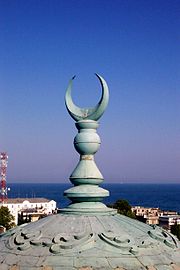





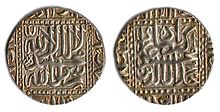


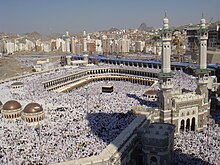





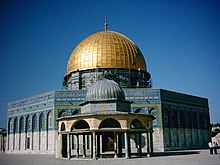
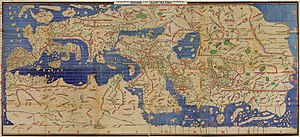
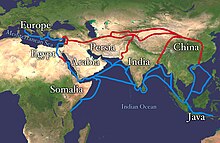


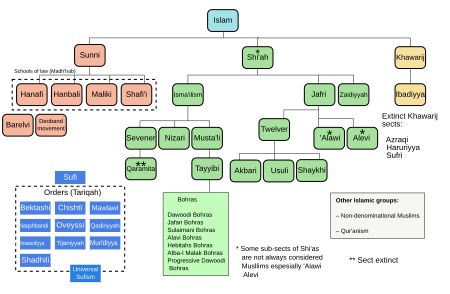





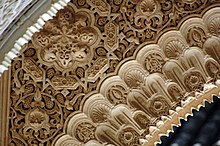
No comments:
Post a Comment
Please leave a comment-- or suggestions, particularly of topics and places you'd like to see covered